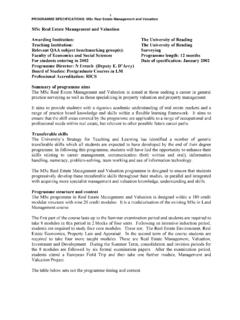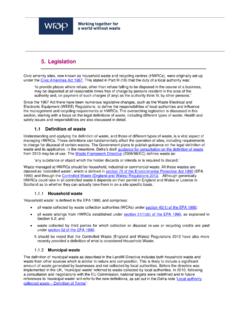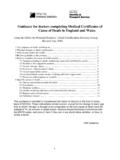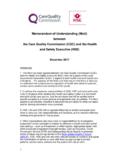Transcription of Guidance on Temperature Control Legislation in …
1 Page 1 of 17 Temperature Control Guidance Summer 2006 DRAFTG uidance on Temperature Control Legislation inEngland, Wales and Northern IrelandContentsSectionParagraphsIntroduc tion1-6 The General Requirement7-9 Foods subject to Temperature control10-16 Cooling of food17-18 Hazard analysis19-21 Good Practice Guides22 Product specific food hygiene regulations23-24 National regulations25-27 Chill Control requirements28-37 Upward variation from the 8 C maximum chill temperature38-44 Hot holding controls45-50 Annex51-71 Page 2 of 17 Temperature Control Guidance Summer 2006 DRAFTI ntroduction1.
2 Temperature Control requirements in the hygiene Legislation are to be found in thefollowing regulations: EC Regulation 852/20041 EC Regulation 853/20042 The Food Hygiene Regulations 200632. This Guidance is intended to help explain for both food businesses andenforcement authorities the food Temperature Control requirements, which willoperate in england , Wales and Northern Ireland. Separate Guidance is available inScotland, where different national rules apply. This Guidance contains advice onthe types of foods that are required to be held under Temperature Control . It alsogives Guidance on the circumstances when some flexibility from the temperaturecontrol requirements is While it is intended to be helpful, this Guidance does not provide an authoritativeinterpretation of the law and is no substitute for an understanding of the legalrequirements.
3 Any examples given are illustrative and not This Guidance is intended to complement best practices in the food industry whichmight involve, for example, keeping foods at chill temperatures below the legalmaximum and thereby providing additional assurances of food Advice on the approach to enforcement of the Temperature Control requirements offood hygiene Legislation is to be found in the Food Law Codes of Practice issuedby the Agency under the Food Safety Act 1990 in england , Wales and The FoodSafety (Northern Ireland) Order 1991 in Northern Guidance on the other aspect of the regulations and further information, includingGood Practice Guides, is available from our website at 1 Regulation (EC) No 852/2004 on the hygiene of foodstuffs2 Regulation (EC) No 853/2004 laying down specific hygiene rules for food of animal origin3 Separate Legislation applies across the three countries: The Food Hygiene ( england ) Regulations 2006(SI 2006/14); The Food Hygiene (Wales) Regulations 2006 (SI 2006/31 ( )); and.
4 The Food HygieneRegulations (Northern Ireland) 2006 (SR 2006 No 3)Page 3 of 17 Temperature Control Guidance Summer 2006 DRAFTThe General Requirement7. EC Regulation 852/2004 contains a general requirement for Temperature Control ,as set out in Annex II, Chapter IX, 5 Raw materials, ingredients, intermediate products and finished products likely tosupport the reproduction of pathogenic micro-organisms or the formation oftoxins are not to be kept at temperatures that might result in a risk to cold chain is not to be interrupted. However, limited periods outsidetemperature Control are permitted, to accommodate the practicalities of handlingduring preparation, transport, storage, display and service of food, provided thatit does not result in a risk to The general requirement applies to all forms of Temperature Control , including chillcontrol and hot holding.
5 Food businesses handling the specific products of animalorigin covered by EC Regulations 853/2004 (see paragraphs 23 and 24) mustcomply with this general requirement. This differs from the previous regulatoryregime where the general requirement did not apply to businesses subject toproduct specific temperatures will only "result in a risk to health" where Temperature Control iscritical to the safety of food. For example, chill Control will not be a requirementwhere food has been subject to a process, such as canning, which prevents thegrowth of pathogenic micro-organisms or the formation of toxins.
6 Nor will it be arequirement where food, such as raw meat, will be cooked so as to ensure it is fitfor human Subject to Temperature Control10. The general requirement applies to all foods likely to support the growth ofpathogenic micro-organisms or the formation of This paragraph gives some examples of various food types that under normalconditions of storage and use and in the absence of adequate preserving factorsshould be kept chilled to help secure food safety. These examples are for generalguidance only and are subject to the exemptions described in paragraphs Dairy productsi.
7 Soft or semi-hard cheeses ripened by moulds and/or important safety factors for cheese relate primarily to its acidity andwater activity. During the ripening process acidity declines until a point isreached where growth of pathogens, such as Listeria, will no longer bePage 4 of 17 Temperature Control Guidance Summer 2006 DRAFT inhibited. It is important that, from this point on, such cheeses are chillcontrolled. See also paragraph 37 (iii).ii. Dairy-based desserts (including milk substitutes), including: fromage frais,mousses, creme caramels and products containing whipped , however, the pH of these products would prevent the growth ofpathogenic micro-organisms or the formation of toxins ( yoghurt with a pHbelow ), or other effective preservative mechanisms are present, the foodwould not need to be subject to Temperature Cooked productsThere will be a need for chill Control of foods comprising or containing cookedproducts such as meat, fish, eggs (or substitutes for meat, fish, or eggs),milk, hard and soft cheese, cereals (including rice)
8 , pulses and vegetables(whether or not they are intended to be eaten without further re-heating).The requirement will include ready-to-eat products such as sandwichescontaining fillings, toppings, etc. prepared with the foods mentioned in theprevious Smoked or cured fishThere is a need for chill Control whether the fish is whole or sliced. In thecase of fresh fish, spoilage organisms (which are obviously detectablethrough appearance or smell) would render the product unfit for consumptionbefore it became unsafe. Because the preservative action of smoking orcuring inhibits the growth of spoilage organisms, chill Control is necessary forsmoked or cured fish to ensure its Smoked or cured ready-to-eat meat which is not ambient shelf-stableExamples may include sliced cured cooked meats such as hams, somesalamis and other fermented sausages, depending on the method of Prepared ready-to-eat foodsIncluding prepared vegetables or salads containing other products (such ascoleslaw)
9 , vegetable salads containing fruit and, prepared products such Uncooked or partly cooked pastry and dough productsExamples include products (such as pizzas, sausage rolls, or fresh pasta)containing meat, fish (or substitutes for meat or fish) or vegetables. Theseproducts often contain pre-cooked meat, fish or vegetables mixed orprepared with raw materials. The subsequent cooking process may bePage 5 of 17 Temperature Control Guidance Summer 2006 DRAFT insufficient in some cases to ensure food safety, so Temperature Control willbe necessary. Fresh pasta should normally be Temperature controlled,whether or not it contains meat, fish or To commit an offence, a food business must be in contravention of the generalrequirement.
10 In most circumstances, food businesses complying with the morespecific national rules (see paragraph 25-27), such as the requirement for amaximum Temperature of 8 C, will also be complying with the general the provision to be breached, even where the food is kept at or below 8 C forexample, a maximum chill Temperature lower than 8 C would need to be critical tofood safety. It would be necessary for an enforcement authority to prove a risk tohealth for any food alleged to be in breach. This may be demonstrated, forexample, by scientific evidence. Observance of Temperature recommendationswithin any special storage conditions on food labels, including recommendationsfor chill temperatures lower than 8 C, is not automatically mandatory.















